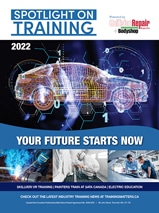UNDERSTAND THE FUTURE AND UPSKILL ACCORDINGLY
BY DARRYL SIMMONS
Do you love your job? If you can answer with a “yes,” and you work in the collision repair industry, you’re off to a great start.
The automotive world is changing at a breakneck pace. That’s the simple truth. Just think about how much the job has changed in the last decade, if you’ve been around the space for that long. If you’re unaware, here’s a little picture: the materials, tools, processes, technology…even the very vehicles we work on are becoming more and more impressively advanced with each and every model year.
The pace of change can feel dizzying. It’s understandable if you feel the desire to cling to the familiar. But, as members of this industry, we can’t stay still for long. If you crave long-term success in this industry, you need to leave the familiar behind and jump head-fi rst into the future.
The collision repair professionals who will thrive in the years to come are those that embrace change, who see it as an opportunity rather than a threat. They’re the ones constantly upskilling, seeking new ways to leverage themselves as a valuable employee, seeking the latest stateof- the-art certifi cations and training. They position themselves as the go-to experts on the production fl oor. They understand emerging technologies. Their colleagues seek them when they need an answer to tough questions.
Take ADAS and full-on autonomous vehicle systems, for instance. These hyper-advanced driver assistance features are becoming increasingly common, not just in luxury models, but in everyday consumer cars. Every new model sold in North America next year will incorporate some kind of ADAS. For collision repair techs, that means a whole new skillset is required—a skillset focused on precise calibration, programming and integration. It’s a challenge, to be sure, but also an incredible chance to showcase your value and expertise.
Or consider the shift towards lightweight, high-strength materials like carbon fi bre and aluminum. Painters have had to completely rethink their approach, mastering new colormatching processes and paint technologies. But the shops and individuals who have risen to that challenge? They’re the ones commanding premium prices and attracting the most discerning customers.
The bottom line is that the future of collision repair is happening right now. And the surest way to future-proof your career is to embrace that future with open arms. That means getting comfortable with the idea of lifelong learning, of continuously expanding your skillset to keep pace with industry changes.
It might seem daunting, I know. After all, you’ve already put in countless hours honing your craft. But think of it this way—the more you invest in your own development, the more valuable and indispensable you become. The collision repair shops of tomorrow aren’t just going to want talented techs and painters—they’re going to demand tech-savvy, forward-thinking problem-solvers who can tackle any challenge that comes their way.
























